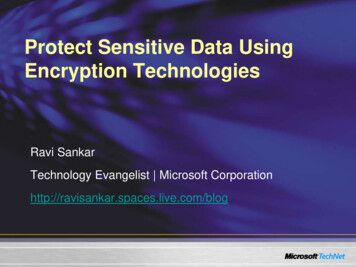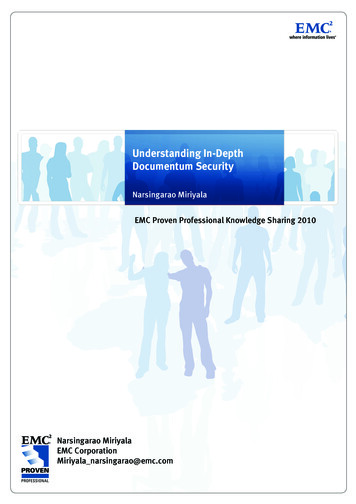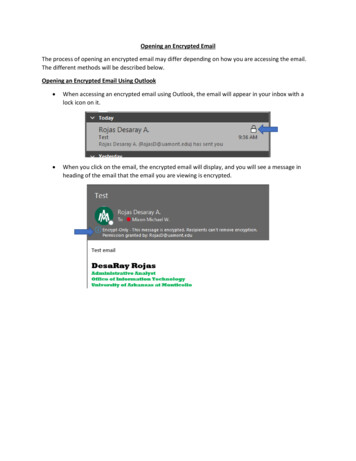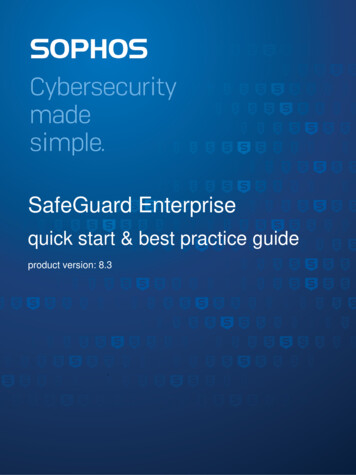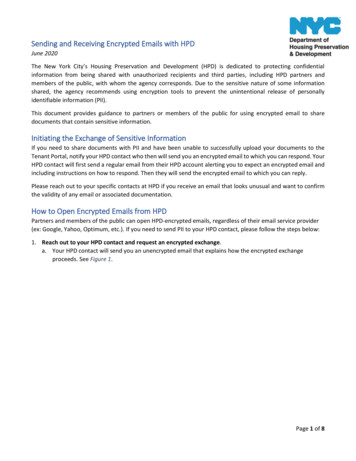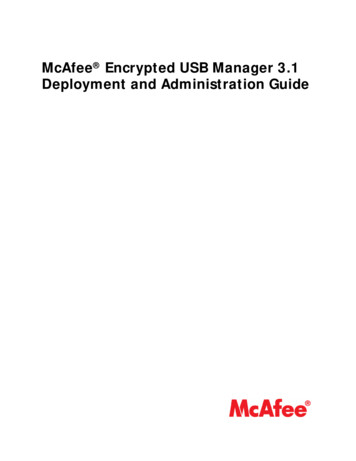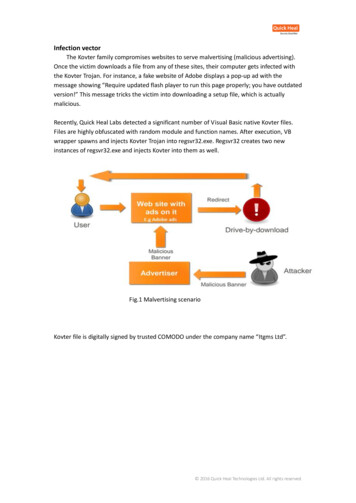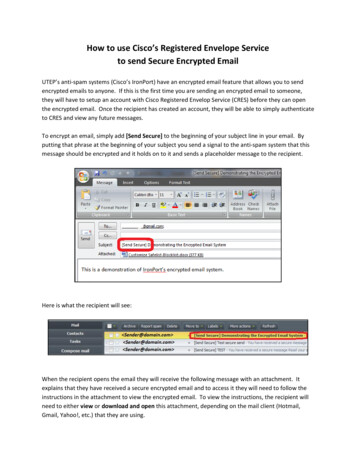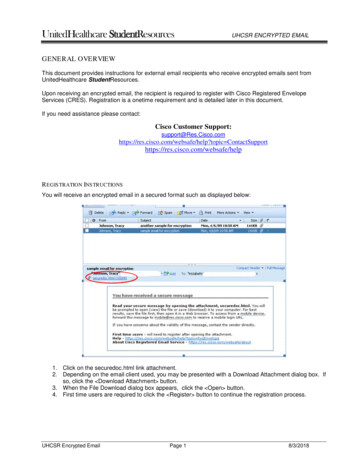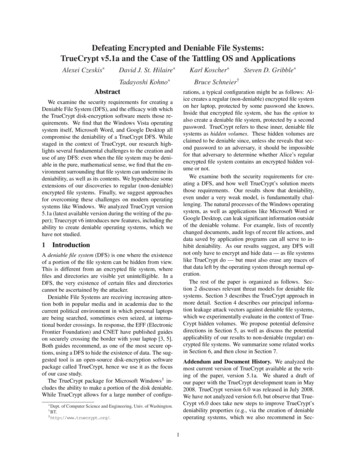
Transcription
Defeating Encrypted and Deniable File Systems:TrueCrypt v5.1a and the Case of the Tattling OS and ApplicationsAlexei Czeskis David J. St. Hilaire Karl Koscher Tadayoshi Kohno AbstractBruce Schneier†rations, a typical configuration might be as follows: Alice creates a regular (non-deniable) encrypted file systemon her laptop, protected by some password she knows.Inside that encrypted file system, she has the option toalso create a deniable file system, protected by a secondpassword. TrueCrypt refers to these inner, deniable filesystems as hidden volumes. These hidden volumes areclaimed to be deniable since, unless she reveals that second password to an adversary, it should be impossiblefor that adversary to determine whether Alice’s regularencrypted file system contains an encrypted hidden volume or not.We examine both the security requirements for creating a DFS, and how well TrueCrypt’s solution meetsthose requirements. Our results show that deniability,even under a very weak model, is fundamentally challenging. The natural processes of the Windows operatingsystem, as well as applications like Microsoft Word orGoogle Desktop, can leak significant information outsideof the deniable volume. For example, lists of recentlychanged documents, audit logs of recent file actions, anddata saved by application programs can all serve to inhibit deniability. As our results suggest, any DFS willnot only have to encrypt and hide data — as file systemslike TrueCrypt do — but must also erase any traces ofthat data left by the operating system through normal operation.The rest of the paper is organized as follows. Section 2 discusses relevant threat models for deniable filesystems. Section 3 describes the TrueCrypt approach inmore detail. Section 4 describes our principal information leakage attack vectors against deniable file systems,which we experimentally evaluate in the context of TrueCrypt hidden volumes. We propose potential defensivedirections in Section 5, as well as discuss the potentialapplicability of our results to non-deniable (regular) encrypted file systems. We summarize some related worksin Section 6, and then close in Section 7.We examine the security requirements for creating aDeniable File System (DFS), and the efficacy with whichthe TrueCrypt disk-encryption software meets those requirements. We find that the Windows Vista operatingsystem itself, Microsoft Word, and Google Desktop allcompromise the deniability of a TrueCrypt DFS. Whilestaged in the context of TrueCrypt, our research highlights several fundamental challenges to the creation anduse of any DFS: even when the file system may be deniable in the pure, mathematical sense, we find that the environment surrounding that file system can undermine itsdeniability, as well as its contents. We hypothesize someextensions of our discoveries to regular (non-deniable)encrypted file systems. Finally, we suggest approachesfor overcoming these challenges on modern operatingsystems like Windows. We analyzed TrueCrypt version5.1a (latest available version during the writing of the paper); Truecrypt v6 introduces new features, including theability to create deniable operating systems, which wehave not studied.1Steven D. Gribble IntroductionA deniable file system (DFS) is one where the existenceof a portion of the file system can be hidden from view.This is different from an encrypted file system, wherefiles and directories are visible yet unintelligible. In aDFS, the very existence of certain files and directoriescannot be ascertained by the attacker.Deniable File Systems are receiving increasing attention both in popular media and in academia due to thecurrent political environment in which personal laptopsare being searched, sometimes even seized, at international border crossings. In response, the EFF (ElectronicFrontier Foundation) and CNET have published guideson securely crossing the border with your laptop [3, 5].Both guides recommend, as one of the most secure options, using a DFS to hide the existence of data. The suggested tool is an open-source disk-encryption softwarepackage called TrueCrypt, hence we use it as the focusof our case study.The TrueCrypt package for Microsoft Windows1 includes the ability to make a portion of the disk deniable.While TrueCrypt allows for a large number of configu-Addendum and Document History. We analyzed themost current version of TrueCrypt available at the writing of the paper, version 5.1a. We shared a draft ofour paper with the TrueCrypt development team in May2008. TrueCrypt version 6.0 was released in July 2008.We have not analyzed version 6.0, but observe that TrueCrypt v6.0 does take new steps to improve TrueCrypt’sdeniability properties (e.g., via the creation of deniableoperating systems, which we also recommend in Sec- Dept. of Computer Science and Engineering, Univ. of Washington.† BT.1 http://www.truecrypt.org/.1
tion 5). We suggest that the breadth of our results forTrueCrypt v5.1a highlight the challenges to creating deniable file systems. Given these potential challenges, weencourage the users not to blindly trust the deniabilityof such systems. Rather, we encourage further researchevaluating the deniability of such systems, as well as research on new yet light-weight methods for improvingdeniability.2be able to deny their existence. If the secret police areable to obtain disk snapshots at close enough intervals,the existence of any deniable files will be obvious, sinceseemingly random bytes on the hard drive will change.Still, we would like any DFS to provide as much securityas possible along the continuum of increasingly severethreat models.In this paper, we examine attacks against a DFS under the most restrictive threat model: one-time access.Clearly, a successful attack under this threat model implies a successful attack under the less restrictive threatmodels.Threat ModelAlice is a human-rights worker, and keeps sensitive information on her computer. The data is encrypted, butshe is concerned that the secret police will seize her computer and, noticing that part of the disk is encrypted,threaten her — or worse — for the key. She needs toprotect her data in such a way that it is deniable: theremust be nothing that would indicate to the secret policethat there are hidden files on her computer. If she deniesthe existence of certain files, and the police later discoverthe existence of those files on her computer, she could bevulnerable to severe punishment.Encrypted file systems such as Microsoft’s BitLockerwill not suffice; encryption does not hide the existenceof data, it only makes the data unintelligible without thekey. This is precisely the sort of scenario that requires aDFS.However, it is exactly these restrictive security requirements that make a DFS difficult to implement.Breaking the security of a DFS does not require decrypting the data; it only requires proving that (or insome cases simply providing strong evidence that) theencrypted data exists.There are several threat models against which a DFScould potentially be secure:3TrueCryptTrueCrypt is a free disk encryption application that provides on-the-fly-encryption for Microsoft Windows.2TrueCrypt has the ability to create deniable hiddenvolumes. These TrueCrypt hidden volumes are optionally – hence deniably – placed inside non-hidden, regularencrypted volumes.Outer (Non-Hidden, Regular) Encrypted Volumes. Aregular (non-hidden) TrueCrypt encrypted volume can bestored (in encrypted form) as a file on top of a regularfile system. For example, a TrueCrypt encrypted volume could be stored as the file C:\TCContainer. Alternately, a TrueCrypt encrypted volume could occupya dedicated partition on a disk. In either case, the encrypted volume is referred to as a TrueCrypt container.To decrypt a TrueCrypt container, the user must providethe password and keyfiles (if there were any) that wereused when creating the volume. We do not describe thedetails of the TrueCrypt encryption and decryption algorithms since we (largely) treat TrueCrypt as a black box. Regular Access. The attacker has many snapshots ofthe disk image, taken in short intervals. An example would be if the secret police break into Alice’sapartment every day when she is away, and make acopy of the disk each time.Hidden Volumes. TrueCrypt provides a DFS througha feature known as a hidden volume. A hidden volumeis a TrueCrypt volume stored inside the container of aregular, non-hidden TrueCrypt volume. A hidden volume requires its own password, and — if the hiddenvolume’s password is not supplied (or supplied incorrectly) — the hidden volume’s data will appear as random data. Since free space in a regular (outer) TrueCryptvolume is, according to the documentation, filled withrandom data, this provides plausible deniability to an attacker under the one-time access threat model. Namely,such an attacker, even if given access to the passwordfor the outer encrypted volume, should not be able to determine whether the random data at the end of the outerencrypted volume is really just random data, or whetherit corresponds to an encrypted hidden volume. The True-Clearly there is a point where the adversary is so powerful that even a DFS won’t protect Alice. If Alice isworking on files in the deniable portion of her computerwhen the secret police break down her door, she will not2 The current version of TrueCrypt (version 5.1a) also providesLinux and OS X implementations, but neither of these implementations support deniable file systems, and hence we do not consider theseimplementations in this paper. Prior to a recent code rewrite, older versions of Linux TrueCrypt supported hidden volumes. One-Time Access. The attacker has a single snapshot of the disk image. An example would be whenthe secret police seize Alice’s computer. Intermittent Access. The attacker has several snapshots of the disk image, taken at different times. Anexample would be border guards who make a copyof Alice’s hard drive every time she enters or leavesthe country.2
Crypt documentation concludes that a person with a hidden volume could therefore convincingly deny the hidden volume’s existence.3hidden volumes as a case study. These classes all sharethe following traits: the information is leaked out aboutthe hidden volumes and the files contained therein after the hidden volume is mounted, and the informationis not securely destroyed after the hidden volume is unmounted.In more detail, the three classes of information leakagethat we consider are:Interface to Windows. The TrueCrypt application exposes several options to users wanting to mount a regularor hidden volume, including: mount type (whether thevolume should be mounted as a fixed file system or a removable file system), writability (read-only or not), andmount point (e.g., E:).TrueCrypt also exposes sufficient information to theWindows operating system to allow Windows to mountand interact with the contents of TrueCrypt volumes (after the relevant passwords or other credentials are entered). We return to specifics of this exposed informationlater. Through the Operating System. Modern operatingsystems are complex, with many unexpected andunintuitive behaviors. Operating systems are notdesigned with the goal of preserving the deniabilityof deniable file systems. Therefore, the natural execution of an operating system may leak informationabout the existence of a deniable file system, even ifthe deniable file system is cryptographically secure.Information Leakage from Below. The TrueCrypt documentation already includes some recommendations andcaveats for the use of hidden volumes.4 The principal recommendations are to be cautious about the mediaon top of which a TrueCrypt hidden volume is stored.Namely, suppose a TrueCrypt volume (and its associated outer volume) are stored on a USB stick. Thenwear leveling (a physical property of how data is sometimes stored on USB sticks) could reveal informationabout the existence of the hidden volume. The TrueCrypt documentation similarly advises against storing aTrueCrypt container on top of a journaling file system.We stress that these existing recommendations focus onbeing cautious about the media underlying a TrueCryptcontainer. Our research focuses on information leakagefrom above — i.e., information that might leak out abouta TrueCrypt hidden volume when the hidden volume ismounted and the operating system and applications areinteracting with the hidden files.The TrueCrypt documentation also rightly observesthat an adversary with greater than one-time access (i.e.,intermittent or regular access) to the TrueCrypt containercould discover the existence of a TrueCrypt hidden volume; for example, by analyzing the differences betweenmultiple snapshots of a TrueCrypt container. Our analyses therefore focus on the weaker case in which the adversary is only given one-time access to the system.4 Through a Primary Application. A deniable file system does not exist in isolation. Rather, people create deniable file systems in order to hide content thatthey are currently using and plan to use in the future.In order to use those files, these people must runan application (like Microsoft Word, Adobe PhotoShop, and so on). These applications, which are notdesigned to preserve deniability, may leak information about the existence of those files. Through a Non-Primary Application. Many computers often run non-primary applications, or applications that (at first glance) appear to be unrelatedto the files stored on a hidden volume. For example,many users run applications like Google Desktopand anti-virus software that might interact poorlywith the deniability of a hidden volume.We present experiments showing that the above information leakage classes are not hypothetical. Our resultshighlight the subtleties and challenges to building deniable file systems.4.1Example Leakage Through the OS: ShortcutsThe TrueCrypt documentation observes that informationabout TrueCrypt is stored in the Windows Registry.5This information reveals the fact that a person used TrueCrypt on his or her machine, and the locations at whichTrueCrypt volumes were mounted (e.g., E:). But thisinformation does not reveal the container’s file name, location, size, nor the type of volume that was mounted.Hence, the Windows registry does not appear to directlycompromise the deniability of a TrueCrypt hidden volume.We do not consider the Windows registry further, butinstead turn to another artifact of the Windows operatingInformation Leakage from AboveWe evaluate three general classes of information leakagevectors against deniable file systems using TrueCrypt’s3 We have not verified that the free space at the end of a regular TrueCrypt volume is in fact filled with random data. Such an analysis wouldbe orthogonal to our principle focus of studying TrueCrypt’s black-boxinteraction with the operating system and surrounding applications. Afailure to fill the free space with random data would, however, allowfor a simple attack against the deniability of the hidden volume.4 http://www.truecrypt.org/docs/?s hidden-volume-precautions.5 http://www.truecrypt.org/docs/?s windows-registry.3
system: shortcuts.6 A shortcut, or .lnk file, is a link toanother file. For example, the shortcut C:\shortcut.lnk might link to the file D:\realfile.doc; doubleclicking on C:\shortcut.lnk would cause MicrosoftWord to open D:\realfile.doc. These links providesa convenient way to access files and folders.Shortcuts can be created in multiple ways, including by users and by programs. Perhaps surprisingly, Windows automatically creates shortcuts tofiles as they are used, and in Vista these shortcuts are stored in a folder called Recent Items thatis located in \. For example, if a user recentlyopened the files E:\File1.doc and E:\File2.doc,shortcuts to these two files would be in the RecentItems directory. A wealth of information can be obtained from a .lnk file, including the real file’s file name,location, attributes, length, access time, creation time,modification time, volume type, and volume serial number of the file system on which the real files are stored [4].Suppose Alice stores the file BadStuff.doc on a hidden volume, edits that document while on a plane, andthen closes Word and unmounts the hidden volume before passing through customs. If the customs officerinspects the Alice’s disk, he or she will quickly discover that Alice was editing this file — which alonemight be significantly compromising information for Alice. Worse, even if the file had an innocuous name likeGoodStuff.doc, the customs officer can exploit the volume serial number field in the .lnk file in the RecentItems directory to garner significant evidence that Alicewas using a hidden volume.As additional setup for the latter, recall that in the U.S.it is a crime to lie to a federal law enforcement officer [3].This means that if Alice chooses to answer a customagent’s question about whether she has a TrueCrypt hidden volume, Alice must answer truthfully. Suppose firstthat a customs agent asks if Alice uses TrueCrypt. Theonly answer Alice can supply is “yes,” since evidenceof TrueCrypt’s usage is stored in the Windows registry(and cannot be safely or reliably deleted, according tothe TrueCrypt documentation). Next, suppose that thecustoms agent asks Alice to identify and mount all theTrueCrypt volumes on her machine, as well as all herother mountable file systems and USB sticks, and thatshe does so except for the hidden volume.The critical observation here is that each of thesemounted volumes has a unique volume serial number.While this volume serial number is not available in theregistry, it is available to applications after the volumesare mounted and is also stored in the shortcut .lnk files.The customs agent can now compare the volume serialnumbers in the relevant .lnk files to the volume serialnumbers for all the volumes that Alice mounted and, ifthere is discrepancy, he knows that there exists or existeda file system that Alice is not disclosing.While the above scenario is described in real-time; thatis, happening while Alice is in the presence of the customs agent, the customs agent could collect similar evidence by simply cloning Alice’s hard drive and, either atthat time or later, asking her to supply all her passwords.We view the above scenario as plausible given the current political environment [3, 5, 8], and even more likelyin other countries. Even if such a scenario were unlikely,we view the potential for such a scenario — coupled withthe well-known fact that users have difficultly followingsecurity protocols — to be sufficiently risky to advocatenot trusting in the deniability of TrueCrypt hidden volumes.4.2Example Leakage Through the Primary Application: Word Auto SavesIn order to dampen data loss in the case of a crash, manyapplications use backup or recovery files. When editing a file, the application will create a local copy of thefile and record in it all changes made to the original file.When the application successfully closes and saves allmodifications, the backup file is removed. It makes sensethat these applications store backup files locally in casean external volume is prematurely unmounted (such asremoving a USB stick before it finishes syncing, or anemergency power-off). For example, Microsoft Word20077 by default creates auto-recover files in The consequence of this auto-recover mechanism isthat a file that was originally stored in a hidden volumehas now been copied to the local hard disk. AlthoughWord removes the backup file after the user closes theprimary file, Word does not invoke secure delete. Wewere repeatedly able to recover previously edited filesthat were stored on the hidden volume by running a simple, free data recovery tool.Specifically, we first ran cipher /w:c:\8 to cleanup any dirty free space. We then mounted a hidden TrueCrypt volume on which we had previouslystored seven copies of the Declaration of Independence of the United States of America titled as variantsof OverthrowGovernment.doc. We then opened andedited these files with Microsoft Word, saved the changesto the original files, exited Word, and unmounted the hidden volume — all things an ordinary user might be reasonably expected to do while using a TrueCrypt volume.7 Word 2007 (12.0.6311.5000) SP1 MSO (12.0.6213.1000) Part ofMicrosoft Office Home and Student 2007.8 A Windows command that writes 0x00, 0xFF, and then randomdata to all free space blocks on a disk.6 Ourexperiments were with Windows Vista Business edition withService Pack 1, though our results apply more broadly.4
Without rebooting, we ran a simple, free data recovery tool.9 The number of files we recovered and theirquality was not consistent on every experiment, since thefree space on the C: drive can be changed at any moment. Nevertheless, we were able to fully recover mostof the documents in their entirety from the Word autorecovery folder. After a fresh experiment that includeda reboot after the hidden volume was unmounted, halfof the files were still recoverable. We hypothesize thatwe could have recovered even more data if we had performed more sophisticated techniques such as examiningthe individual file blocks on disk.Furthermore, in cases when an application is prematurely terminated — for example, during a crash or bya kill command — the auto-recover file will persist onthe local disk in clear view and will be recovered byMicrosoft Word without the TrueCrypt volume beingmounted. This means that just pulling the power on one’scomputer at the sight of authorities will not safeguard afile if it was open or in the process of being edited.While Microsoft Word presents users with the abilityto prevent auto-saves from occurring through the preferences dialog, other applications may not. An attackercan use information gleamed from these files — as wellas other information leakage from the primary application — to not only infer that a hidden volume exists, butalso recover some of its contents.4.3ers to include and exclude from indexing. However,Google Desktop claims that all fixed drives will be indexed by default. As a user opens documents, modifiesthem, and saves them, Google Desktop caches snapshotsof the files and stores them for later viewing. GoogleDesktop provides not only the latest cached version of afile but also multiple versions of a file cached at differenttimes. These cached files could provide an attacker withnot only the current state of a document but also a viewof its evolution over time.In our tests we created a Word document calledOverthrowGovernment.doc in a TrueCrypt hidden volume and added sections of the Declaration of Independence to the document. With Google Desktop installed11and running, we edited and saved the document numerous times. After unmounting the TrueCrypt hidden volume, we were easily able to recover a number of snapshots of our file by merely searching for any word contained in the file. We were able to repeat these resultsirrespective of the volume’s mount point (any drive letterF, G, H, L) or mount type (normal/fixed and removablemedium). See Figure 1.Thus, to protect oneself, the user cannot rely on onlytweaking TrueCrypt’s settings, but rather must understand the dangers presented by the non-primary application itself. In the case of Google Desktop, one oftwo choices could be made to prevent Google Desktopfrom leaking file contents out of TrueCrypt volumes. Theuser can either forgo the features of Google Desktop Enhanced Search, forcing it into a limited mode of operation, or the user can make the conscious choice to eithershut down Google Desktop or pause its indexing whenever using a TrueCrypt volume. This burden of needingto understand exactly how a non-primary application interacts with a TrueCrypt volume underscores the difficulties of implementing and using a DFS.While non-primary applications such as Google Desktop may allow the user to pause its actions at arbitrarypoints, other non-primary applications may not providethe user with this capability even if the user understandsthe dangers posed by the application. In addition, malicious applications, like botnets or viruses, could obviously compromise the deniability of a hidden volume inways that the user cannot predict nor prevent.Example Leakage Through A Non-Primary Application: Google DesktopNon-primary applications may also access the filesstored on a hidden volume. For example, desktopsearch applications are becoming more prevalent, allowing users to quickly navigate their computers. However,in addition to merely indexing the files on a computerto aid in searching for files, at least one desktop searchapplication — Google Desktop10 — includes an additional feature that presents problems for a DFS. This feature is the ability to view previous states of websites andfiles such as Microsoft Word documents. According toGoogle, the purpose of this caching feature is to recoveraccidentally deleted files or to simply view an old version of a file or web page. The default installation ofGoogle Desktop does not provide for the indexing orcaching of files; however, this basic mode of operationlimits Google Desktop’s ability to assist the user. Wheninstalling Google Desktop, the user merely needs to select the “Enhanced Search” option to enable both the indexing and caching of certain files types.To protect privacy and to optimize searched areas, theuser is provided with the ability to choose which fold-55.1Defensive DirectionsIt may be possible to address each of the abovementioned information leakage vectors in isolation. Forexample, to counter the Windows shortcut-based attack,TrueCrypt may consider using the same serial numberfor all volumes, serial numbers that are a function of the9 http://tokiwa.qee.jp/EN/dr.html;10 http://desktop.google.com/;Future DirectionsDataRecovery 2.4.2.we evaluated version11 Default5.7.0805.16405-en-pb.5install with Enhanced Search enabled.
Figure 1: Information leakage through Google Desktop. The TrueCrypt hidden volume has been unmounted, and yetwe can recover numerous snapshots of the hidden file’s contents.formation from a hidden volume.12 Robust applicationsshould accept the fact that they cannot store temporaryfiles and either alert the user that a feature is not available(like auto-recovery) or silently fail (like saving a shortcutto a recent document). Less robust applications may notwork under this new restriction. However, the fact thatapplications no longer work tells the user that application will leak potentially private information. The usercan then weigh the risks and benefits of using the application in an unprotected manner, and manually allow theapplication to work outside the protection scheme.While this does not provide 100% protection, it maywork well enough to stop typical information leaks. Forexample, a process may leak information about a hiddenvolume to another process via IPC or a network connection, and that second process may write this informationto a non-hidden volume. However, we hypothesize thatthese situations are rare in practice, and that this minimalist information flow approach will substantially improve the deniability of hidden volumes; users must stillavoid being lulled into a false sense of additional securitygreater than what is actually afforded.Another possible direction would be to create a “TrueCrypt Boot Loader” that, upon entering one password,decrypted the disk one way and booted the OS. And,upon entering a different password, decrypted the deni-mount point, random serial numbers each time, or somecombination of the above. Other ad hoc approaches mayalso be successful at addressing this particular information leakage channel.However, such ad hoc approaches do not solve the fundamental problem: the operating system and applicationscan leak significant information about the existence of,and the files stored within, a hidden volume. We haveidentified three broad classes of information leakage vectors, with concrete examples for each class. However,we are sure that other examples likely exist, waiting tobe discovered. The problem is therefore much more fundamental, and addressing it will require rethinking andreevaluating how to build a true DFS in the context ofmodern operating systems and applications.To create a DFS, it seems inevitable that the operating system (and perhaps the underlying hardware) mustassist in the deniability. New operating system architectures like HiStar [10] could help ensure that informationabout a DFS does not leak to other portions of a system. However, the strong information flow guaranteesafforded by such architectures may be overkill to preventthe most typical information leaks. Moreover, these architectures require significant changes to the operatingsystem.An approach that may work well with existing operating systems is to install a file system filter that disallowsa process any write access to a non-hidden volume (orthe registry, under Windows) once that process reads in-12 It may also be desirable to mark certain applications, such asGoogle Desktop, as never being allowed to read a hidden volume, lestthey be permanently tainted with knowledge of the forbidden data.6
able portion of the disk and booted the OS in the deniablepartition. (Addendum: such a boot loader is now implemented in TrueCrypt v6.0.)We leave other specific directions as open problems.5.2in which computers are searched at international bordersand the broad media discussions about the advantages ofdeniable file systems like TrueCrypt’s, e.g., [3, 5, 8].On the other hand, even if a DFS is secure, it mightnot be a good solution to Alice’s secret-police problem.Just as an attacker would not be able to prove the existence of secret data under such a secure DFS, the sameattacker wouldn’
regular (non-hidden) TrueCrypt encrypted volume can be stored (in encrypted form) as a file on top of a regular file system. For example, a TrueCrypt encrypted vol-ume could be stored as the file C:\TCContainer. Al-ternately, a TrueCrypt encrypted volume could occupy a dedicated partition on a disk. In either case, the en-
